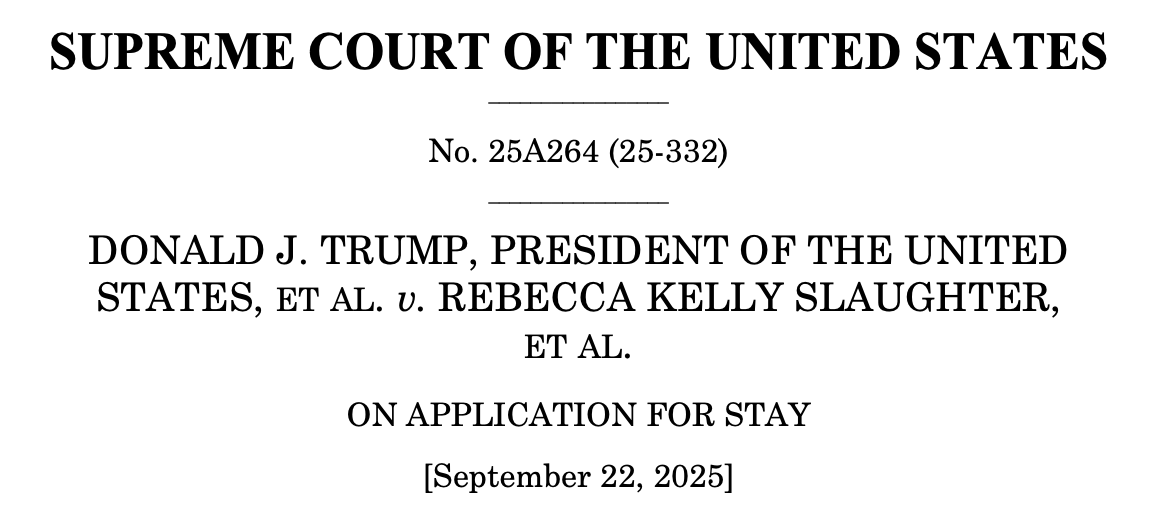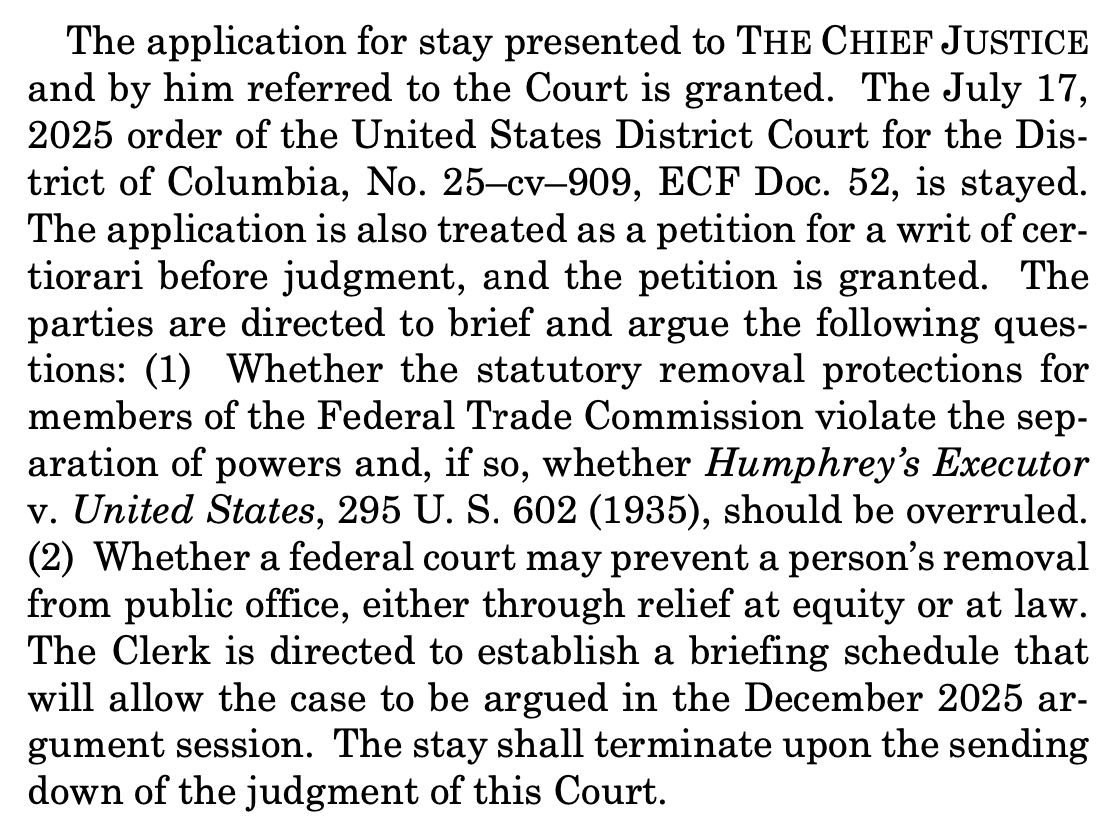SCOTUS majority says Trump can ignore precedent if the majority doesn't like it
A 90-year-old precedent meant nothing to the majority allowing Trump to fire an FTC commissioner during litigation. This is no way to run a court, let alone a country.
The U.S. Supreme Court’s Republican appointees on Monday issued an order allowing President Donald Trump’s purported firing of Rebecca Slaughter as a Democratic commissioner of the Federal Trade Commission to take effect while litigation proceeds, while also stating that the court would be taking up the Justice Department’s appeal of the case to decide whether a 90-year-old precedent that would bar Trump’s firing of Slaughter should be overturned.
I am sorry if you needed to read that a few times, but its absurdity needed to be fully laid out and not oversimplified.
Yes, if you’ve gotten it, the Supreme Court is putting the cart before the horse.
The Republican appointees, over the pointed objection of the Democratic appointees, are allowing Trump’s firing to take effect before the court even “decides” whether Trump’s firing is allowed because the majority, in the future, is (apparently) likely to overturn the 90-year-old Humphrey’s Executor precedent.
Under the 1935 ruling, Congress could create agencies that had some independence — for example, by legislating restrictions on presidential removal of officials from the leadership of those agencies — provided the agencies in question have multimember, bipartisan leadership.
This ruling led to a widespread understanding within the federal government, and Congress passed laws — and created so-called independent agencies — accordingly. Chief Justice John Roberts and the conservative majority has pulled back on some of the more loose interpretations of that rule over the past 15 years, like when Congress created the Consumer Financial Protection Bureau and tried to give its single director “for cause” removal protection, but overturning Humphrey’s Executor would be a wholesale pullback of congressional power in this area.
Further still, the majority also asked the parties to brief and argue whether a court can issue an order “prevent[ing] a person’s removal from public office” at all. A ruling in the negative there could make it so that courts are extremely limited in their remedy should a president illegally — or even unconstitutionally — fire someone.
It is an order that either means there is no stability left in the law or, at best, there is no precedent if the reactionary, right-wing-controlled court says so.
And, because of the way the majority is doing this, the Trump administration does not even need to wait for the precedent to be overturned. It can act contrary to precedent, and Chief Justice John Roberts and his merry band of Republican appointees will make it so. Before they formally make it so.
This is not the first time we have seen this move, either. The majority — albeit, without Roberts — did the same thing back in 2021, when they allowed Texas’s S.B. 8 vigilante enforcement ban to go into effect despite the fact that it was clearly unconstitutional then because Roe v. Wade had not yet been overturned.
Although clearly an important matter, the difference is notable. That was over a state law. This is a situation in which the court is allowing a properly enacted federal law — setting forth FTC commissioners’ removal restrictions — to be ignored before ruling on whether it is going to overturn a longstanding precedent that would then allow it to reach a different conclusion about the constitutionality of the law.
Neither is proper. One disrespects federalism (and, in that case, the Supremacy Clause). The other disrespects separation of powers.
Monday’s order from the Supreme Court contained absolutely no reasoning.
Nearly half of the order was setting forth the two questions the court will be considering; the rest was setting forth the procedural orders the majority was issuing:
“The application for stay … is granted.”
Humphrey’s Executor v. United States (1935) notwithstanding.
No justice in the majority even bothered to write to justify their action on Monday. (Justice Neil Gorsuch has no problem writing to demean lower-court judges when he decides they have not properly divined the meaning behind “emergency application” decisions, but he has no such high standards for himself and his colleagues when it comes to explaining those very same shadow docket rulings.)
Justice Elena Kagan again wrote the Democratic appointees’ opinion dissenting from the stay that was granted, joined by Justices Sonia Sotomayor and Ketanji Brown Jackson, and she gave us as close to a warning as she has given this year.
Detailing the repeated stay orders, which reached their crescendo on Monday when the majority issued a stay as to Trump’s purported firing of a commissioner of the very agency at issue in Humphrey’s Executor, Kagan explained the result:
[T]he majority, stay order by stay order, has handed full control of all those agencies to the President. He may now remove—so says the majority, though Congress said differently—any member he wishes, for any reason or no reason at all. And he may thereby extinguish the agencies’ bipartisanship and independence.
The majority simply did that by pure force of their 6-3 majority, not law.
“Under existing law, what Congress said goes—as this Court unanimously decided nearly a century ago,” Kagan wrote of Humphrey’s Executor. “To reach a different result requires reversing the rule stated in Humphrey’s: It entails overriding rather than accepting Congress’s judgment about agency design. The majority may be raring to take that action, as its grant of certiorari before judgment suggests. But until the deed is done, Humphrey’s controls ….”
That was not all, though.
Kagan also had a larger point — which she has certainly made in these cases previously — that reached a sharper conclusion on Monday:
Our emergency docket should never be used, as it has been this year, to permit what our own precedent bars. Still more, it should not be used, as it also has been, to transfer government authority from Congress to the President, and thus to reshape the Nation’s separation of powers.
What Kagan wrote there was undoubtedly true and extremely alarming: The majority has used the shadow docket to take power away from the judicial branch — by ignoring its precedents — and the legislative branch — by ignoring the laws it enacted. In both instance, it has instead given the power to the president.
Meanwhile, as Monday night approached Tuesday, Roberts’s “administrative” stay remained in effect in the case over the Trump administration’s attempted impoundment of more than $4 billion in foreign aid through Trump’s attempted “pocket rescission” that has no place in law.
Roberts’s “administrative” stay has been in place now for 13 days, a full week after the Justice Department’s application was fully briefed.
The stay is, quite simply, allowing the Trump administration to withhold the nearly $5 billion that was allotted by Congress to be spent by the fiscal year ending on September 30 but that Trump is purporting to be able to refuse to spend.
It is yet another case in which the Republican appointees could side with the Republican president to allow him to do whatever he wants.
Laws notwithstanding.





Surely this order already prejudices the case—if SCOTUS will allow Rebecca Slaughter to be continued to be fired … then of course, the law must be wrong. Otherwise, why not put this obviously incorrect move on hold?
Thank you. The ruling is appalling and outrageous.